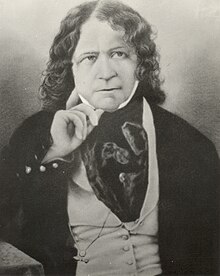William P.C. Barton
| William P. C. Barton | |
|---|---|
 |
|
| Born | November 17, 1786 Philadelphia, Pennsylvania |
| Died |
March 27, 1856 (aged 69) Philadelphia, Pennsylvania |
| Nationality | United States of America |
| Occupation | botanical illustrator, university teacher, physician, botanist |
William Paul Crillon Barton (November 17, 1786 – March 27, 1856), was a medical botanist, physician, professor, naval surgeon, and botanical illustrator.
Barton was born on November 17, 1786, in Philadelphia, Pennsylvania. His father William Barton, a lawyer, was the designer of the Great Seal of the United States. His uncle, Benjamin Smith Barton (1766–1815) was an eminent medical botanist and vice-president of the American Philosophical Society.
As was customary for the era, Barton pursued a classical education at Princeton University, graduating with a Bachelor of Arts degree in 1805. The curriculum included Aristotelian logic, and study of the Greek and Latin languages. While he was at Princeton, each member of his class assumed the name of some celebrated man. The one he chose was , and the initials P. C. were retained by him the rest of his life. Barton began studying medicine at the University of Pennsylvania School of Medicine in 1805 under his uncle, Benjamin Smith Barton, who was a renowned botanist and author of the first American text book on botanical science. In these years of study, William Barton’s interest in botany and the natural sciences grew into a lifelong passion.
In 1808, upon publication of A Dissertation on Chymical Properties and Exhilarating Effects of Nitrous Oxide Gas and Its Application to Pneumatick Medicine, Barton received his medical degree from the University of Pennsylvania. Complete with an illustration of a giddy man breathing in “laughing gas” from a sheep’s bladder, the treatise had great impact on scientific thought when nitrous oxide experiments were “generally derided as extravagant and imaginary.”
At the age of 23, Barton chose to enter the U.S. Navy as a surgeon. He received his commission on April 10, 1809, and less than week later commissioned the famous Thomas Sully to paint his portrait for a sum of $50. This painting, now in the Wilstach Collection at the Philadelphia Museum of Art, shows a young Barton in uniform – a blue coat with gold braid, and hands gloved. Barton wrote, “I was overwhelmed with the difficulties I had to encounter in the performance of professional duties, where every species of inconvenience and disadvantage that can be imagined was opposed to the exertions of the surgeon.” Ultimately, Barton was not one to accept inadequacies, but rather to fight for reform.
...
Wikipedia
